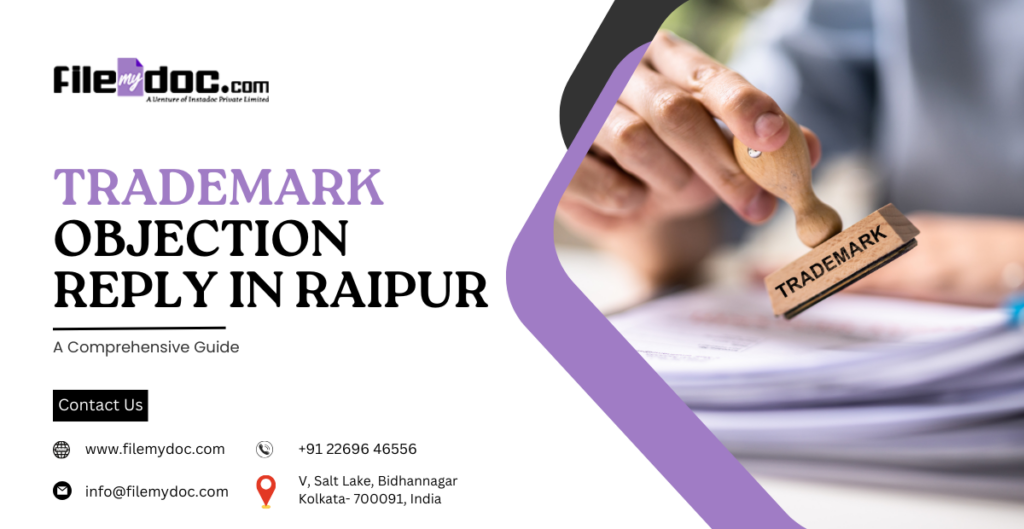Trademark Objection Reply in Raipur: A Comprehensive Guide
Introduction
Navigating the waters of trademark registration can be challenging, especially when you encounter an objection. Understanding how to effectively respond to a trademark objection in Raipur can make or break your brand’s identity. Let’s dive into the essentials of addressing a trademark objection, ensuring your brand’s protection and compliance with legal standards.




Understanding Trademark Objections
What is a Trademark Objection?
A trademark objection is a preliminary refusal issued by the trademark examiner during the trademark registration process. It signifies that there are issues with the application that need to be addressed before the trademark can be registered.
Common Reasons for Trademark Objections
Trademark objections can arise due to various reasons, such as:
- Similarity to an existing trademark
- Lack of distinctiveness
- Incorrect use of trademark class
- Descriptive or generic terms used in the trademark
Trademark Objection Reply in Raipur
Why Raipur?
Raipur, the capital city of Chhattisgarh, is a growing hub for businesses and startups. The city’s legal infrastructure supports trademark registration and dispute resolution, making it an essential location for addressing trademark objections.
The Legal Framework in Raipur
Raipur follows the guidelines set by the Indian Trademark Act, 1999, ensuring that all trademark applications and objections are handled with due diligence and legal scrutiny.
Steps to Handle a Trademark Objection
Initial Review of the Objection Notice
Upon receiving a trademark objection notice, the first step is to carefully review the details and understand the grounds for objection.
Gathering Necessary Documents
Collect all relevant documents, including your trademark application, evidence of usage, and any supporting materials that can strengthen your case.
Drafting a Response
Drafting a comprehensive and clear response is crucial. Your reply should address each objection point, provide justifications, and include any necessary evidence.
Detailed Breakdown of a Trademark Objection Reply
Addressing the Objection Points
Carefully respond to each point raised in the objection notice. Clearly explain why your trademark should be accepted and how it complies with the legal requirements.
Providing Evidence and Justifications
Include evidence such as prior use of the trademark, proof of distinctiveness, and any other relevant documentation that supports your claim.
Formatting and Language Tips
Use formal language and a clear format. Ensure that your reply is well-organized, concise, and free of grammatical errors.
Common Mistakes to Avoid in Trademark Objection Reply
Incomplete Information
Providing incomplete or inaccurate information can lead to rejection. Ensure all necessary details are included.
Missing Deadlines
Trademark objections come with strict deadlines. Missing these deadlines can result in the abandonment of your application.
Ignoring Legal Advice
Legal advice can be invaluable in drafting a successful objection reply. Ignoring it can jeopardize your chances of a positive outcome.
Legal Assistance and Consultation
When to Seek Professional Help
If you are unsure about how to handle the objection, it’s wise to seek help from a trademark attorney.
Benefits of Hiring a Trademark Attorney
A professional can provide expert advice, ensure all legal requirements are met, and improve the chances of your reply being accepted.
Filing Your Trademark Objection Reply
Online Filing Process
The online process involves submitting your reply through the official trademark registry website. Ensure all documents are scanned and uploaded correctly.
Offline Filing Process
For offline submissions, prepare physical copies of your reply and documents, and submit them to the appropriate trademark office.
After Filing the Objection Reply
Follow-up Actions
Stay proactive by following up with the trademark office to track the status of your reply.
Possible Outcomes
The trademark office may accept your reply, request further information, or reject the application. Be prepared for all outcomes.
Maintaining Your Trademark Post-Objection
Regular Monitoring
Once your trademark is registered, monitor it regularly to ensure no infringements occur.
Renewal and Maintenance
Timely renewals and proper maintenance are essential to keep your trademark valid and protected.
Trademark Objection Reply Timeline
Expected Duration
The time frame for resolving a trademark objection can vary. Typically, it takes several months to a year.
Key Milestones
Key milestones include the initial response submission, any further queries from the trademark office, and the final decision.
Cost Involved in Trademark Objection Reply
Filing Fees
There are fees associated with submitting your objection reply, both online and offline.
Professional Fees
If you hire a trademark attorney, there will be additional costs for their services.
FAQs
Q.1 How Long Does the Trademark Objection Process Take?
The process can take anywhere from a few months to over a year, depending on the complexity of the objection.
Q.2 What Happens If I Miss the Deadline?
Missing the deadline can lead to the abandonment of your trademark application. Always keep track of important dates.
Q.3 Can I File the Reply Myself?
Yes, you can, but it is advisable to seek professional help to ensure a thorough and effective reply.
Q.4 What If My Reply Is Rejected?
If your reply is rejected, you may have the option to appeal the decision or make necessary amendments and reapply.
Q.5 How Can I Prevent Future Trademark Objections?
Conduct a thorough search before applying, ensure your trademark is distinctive, and follow all legal guidelines to minimize the risk of objections.
Conclusion
Addressing a trademark objection in Raipur requires a clear understanding of the legal framework and a meticulous approach to drafting your reply. By following the steps outlined in this guide, you can improve your chances of successfully overcoming an objection and securing your trademark. Act promptly, seek professional help when needed, and ensure your brand’s identity remains protected.



























